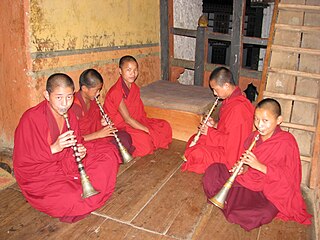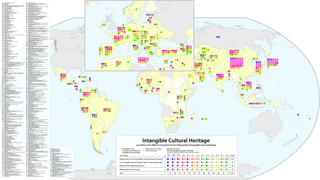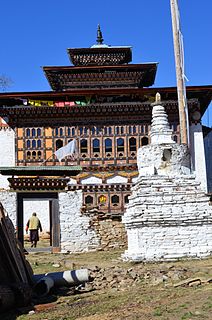Related Research Articles

Thimphu is the capital and largest city of Bhutan. It is situated in the western central part of Bhutan, and the surrounding valley is one of Bhutan's dzongkhags, the Thimphu District. The ancient capital city of Punakha was replaced as capital by Thimphu in 1955, and in 1961 Thimphu was declared as the capital of the Kingdom of Bhutan by the 3rd Druk Gyalpo Jigme Dorji Wangchuck.

Cradled in the folds of the Himalayas, Bhutan has relied on its geographical isolation to protect itself from outside cultural influences. A sparsely populated country bordered by India to the south, and China to the north, Bhutan has long maintained a policy of strict isolationism, both culturally and economically, with the goal of preserving its cultural heritage and independence. Only in the last decades of the 20th century were foreigners allowed to visit the country, and only then in limited numbers. In this way, Bhutan has successfully preserved many aspects of its culture, which dates directly back to the mid-17th century.

The music of Bhutan is an integral part of its culture and plays a leading role in transmitting social values. Traditional Bhutanese music includes a spectrum of subgenres, ranging from folk to religious song and music. Some genres of traditional Bhutanese music intertwine vocals, instrumentation, and theatre and dance, while others are mainly vocal or instrumental. The much older traditional genres are distinguished from modern popular music such as rigsar.
Táncház is a "casual" Hungarian folk dance event. It is an aspect of the Hungarian roots revival of traditional culture which began in the early 1970s, and remains an active part of the national culture across the country, especially in cities like Budapest. Táncház draws on traditions from across the regions of the Kingdom of Hungary, especially music and dance. The term is derived from a Transylvanian tradition of holding dances at individual's homes.
The Proclamation of Masterpieces of the Oral and Intangible Heritage of Humanity was made by the Director-General of UNESCO starting in 2001 to raise awareness of intangible cultural heritage and encourage local communities to protect them and the local people who sustain these forms of cultural expressions. Several manifestations of intangible heritage around the world were awarded the title of Masterpieces to recognize the value of the non-material component of culture, as well as entail the commitment of states to promote and safeguard the Masterpieces. Further proclamations occurred biennially.
A Living Human Treasure is, according to UNESCO, a person who possesses to a high degree the knowledge and skills required for performing or re-creating specific elements of the intangible cultural heritage. This title or a form of it is awarded by the nation's government to a person who is regarded as a national treasure while still alive. The title is also known as Living National Treasure.

Bhutan, officially the Kingdom of Bhutan, is a landlocked country in South Asia. Located in the Eastern Himalayas, it is bordered by the Tibet Autonomous Region of China in the north, the Sikkim state of India and the Chumbi Valley of Tibet in the west, the Arunachal Pradesh state of India in the east, and the Indian states of Assam and West Bengal in the south. Bhutan is geopolitically in South Asia and is the region's second least populous nation after the Maldives. Thimphu is its capital and largest city, while Phuntsholing is its financial center.

Chhau dance, also spelled as Chau or Chhaau, is a semi classical Indian dance with martial, tribal and folk traditions, with origins in eastern India. It is found in three styles named after the location where they are performed, i.e. the Purulia Chau of Bengal, the Seraikella Chau of Jharkhand, and the Mayurbhanj Chau of Odisha.

An intangible cultural heritage (ICH) is a practice, representation, expression, knowledge, or skill considered by UNESCO to be part of a place's cultural heritage; it comprises "nonphysical intellectual property, such as folklore, customs, beliefs, traditions, knowledge, and language" in contrast to tangible heritage. Intangible cultural heritage is considered by member states of UNESCO in relation to the tangible World Heritage focusing on intangible aspects of culture. In 2001, UNESCO made a survey among States and NGOs to try to agree on a definition, and the Convention for the Safeguarding of Intangible Cultural Heritage was drafted in 2003 for its protection and promotion.

Tshechu are annual religious Bhutanese festivals held in each district or dzongkhag of Bhutan on the tenth day of a month of the lunar Tibetan calendar. The month depends on the place. Tshechus are religious festivals of the Drukpa Lineage of the Kagyu school of Tibetan Buddhism.

The dramyin or dranyen is a traditional Himalayan folk music lute with six strings, used primarily as an accompaniment to singing in the Drukpa Buddhist culture and society in Bhutan, as well as in Tibet, Sikkim and Himalayan West Bengal. It is often used in religious festivals of Tibetan Buddhism. The instrument is played by strumming, fingerpicking or plucking. The dramyen, chiwang (fiddle), and lingm (flute) comprise the basic instrumental inventory for traditional Bhutanese folk music.

The Intangible Cultural Properties are aspects of intangible culture that the government of South Korea has officially designated for preservation in accordance with the 1962 Cultural Property Protection Law. They are proclaimed and maintained by South Korea's Cultural Heritage Administration.

Dramitse is a town in Drametse Gewog in the east part of Mongar District, Eastern Bhutan. At the 2005 census, its population was 541. It is situated on a hill opposite the town of Tashigang.

Tourism in Bhutan began in 1974, when the Government of Bhutan, in an effort to raise revenue and to promote Bhutanese unique culture and traditions to the outside world, opened its isolated country to foreigners. In 1974, 287 tourists visited Bhutan. The number of tourists visiting Bhutan increased to 2,850 in 1992, and rose dramatically to 7,158 in 1999. By the late 1980s tourism contributed over US$2 million in annual revenue.

UNESCO established its Lists of Intangible Cultural Heritage with the aim of ensuring better protection of important intangible cultural heritages worldwide and the awareness of their significance. This list is published by the Intergovernmental Committee for the Safeguarding of Intangible Cultural Heritage, the members of which are elected by State Parties meeting in a General Assembly. Through a compendium of the different oral and intangible treasures of humankind worldwide, the programme aims to draw attention to the importance of safeguarding intangible heritage, which UNESCO has identified as an essential component and as a repository of cultural diversity and of creative expression.

Sumtrhang Monastery is a Buddhist monastery in Ura Gewog, Bhutan. It is one of the most important Bhutanese monasteries as descendants from its lineage include Pema Lingpa and hence the Wangchuck Royal family.
Lakhon Khol or Khmer masked drama dance is a dance drama genre that is performed in Cambodia.
Intangible cultural heritage (ICH) includes traditions and living expressions that are passed down from generation to generation within a particular community.

Huaconada is a ritual dance performed in the village of Mito in the province of Concepción in the central Peruvian Andes. It has been inscribed on the Representative List of the Intangible Cultural Heritage of Humanity by UNESCO in 2010.
References
- 1 2 3 Shimizu, Yoshi. "The Mask Dance of the Drums from Drametse of Bhutan". Yoshi Shimizu, Photographer. Retrieved March 20, 2016.
- 1 2 3 4 5 6 7 8 "Mask dance of the drums from Drametse - intangible heritage - Culture Sector - UNESCO". www.unesco.org. Retrieved 2016-03-20.
- 1 2 3 "The Mask Dance of the Drums from Drametse". www.unesco.org. Retrieved 2016-03-20.
- 1 2 3 "Research at the Institute of Language and Culture Studies". Institute of Language and Culture Studies. Archived from the original on March 30, 2016. Retrieved March 20, 2016.
- 1 2 "Japan finances the project "Safeguarding of the Drametse Ngacham"". www.unesco.emb-japan.go.jp. Retrieved 2016-03-20.
- ↑ དགྲ་མེད་རྩེ་རྔ་འཆམ། Drametse Ngacham. Semtokha, Bhutan: Institute of Language and Culture Studies, Semtokha, Royal University of Bhutan. 2009. ISBN 978-99936-771-0-9.
